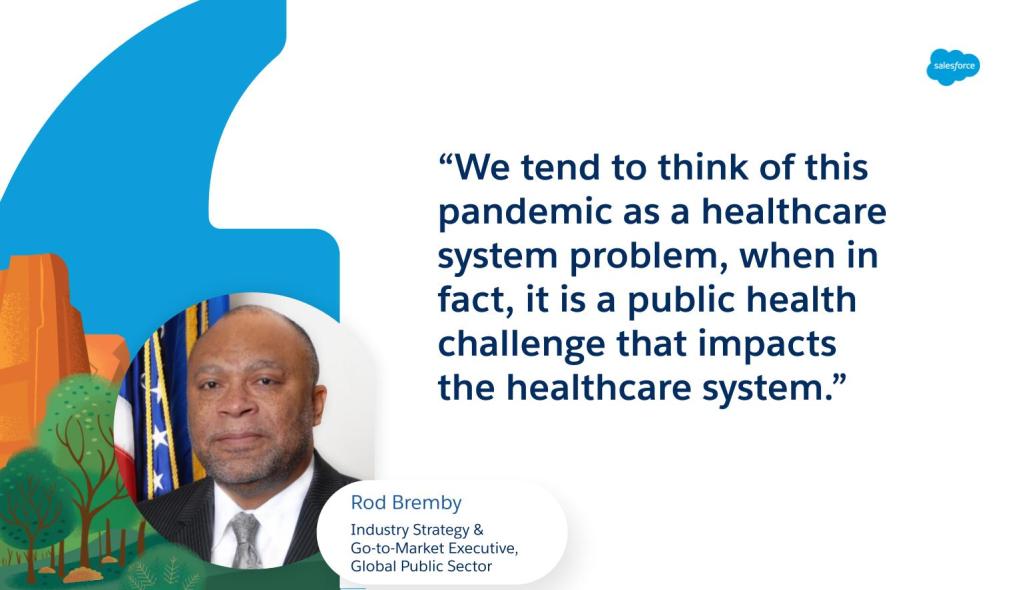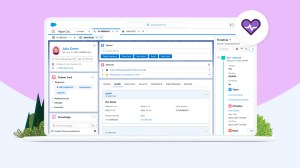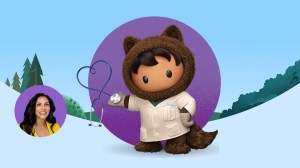Twelve years ago, Rod Bremby was serving as the Secretary of the Kansas Department of Health and Environment, when he helped lead the state’s public health response to the H1N1 pandemic. Today, Rod is a Senior Director of Health and Human Services at Salesforce, leveraging his expertise in the public sector and past health crises to help Salesforce support the public sector’s response to the COVID-19 pandemic.
We sat down with Rod to learn more about how Salesforce has been working with the public sector since the start of this crisis and to learn more about the launch of Vaccine Cloud.
Q. What do you do at Salesforce?
I’m a Salesforce industries executive focused on health and human services. I have an extensive background in the public sector, principally in state and local government, including serving as Connecticut’s Commissioner of Social Services and Kansas’s longest-serving Secretary of the Kansas Department of Health and Environment.
In my role today, I assess and evaluate how the public sector can digitally transform and assist our sales teams and help public sector clients envision what is possible for improving the employee and constituent experiences.
In the context of the COVID-19 pandemic, I’m currently focused on how Salesforce technology can and should be applied to pandemic relief efforts, including supporting manual contact tracking and vaccine management.
Q. You have experience navigating pandemics, having led the State of Kansas’ H1N1 response back in 2009. What was that like? Are there similarities to what you’re seeing with this pandemic?
H1N1 hit in 2009. It was not the virus (H5N1) that many of us in public health were expecting, but in some ways, it’s arrival was even more frightening because H1N1 was a swine flu — like the avian flu that fueled the 1918 Pandemic that killed an estimated 30 to 50 million people globally. But because it was a flu virus, it was believed that a vaccine could be developed rather rapidly to inoculate the public through mass vaccinations. A challenge encountered with the production of H1N1 vaccines was an egg shortage. So the vaccine was delayed coming to market, and by the time it was ready, the U.S. had already experienced its second wave, and many Americans were no longer interested in vaccinations.
That’s not going to be the case for this pandemic. We need vaccines, and we’re going to need to inoculate a record number of people as quickly as possible.
Q. Looking at the collaboration that’s going to be necessary between the healthcare system and the public health system, what challenges do you see ahead?
This pandemic caught us unaware, or at least unprepared in terms of having human and technical resources in place. The most significant gap that stands out is our inability to track vaccinations. Nationally, in the U.S., some 175 million doses of flu vaccine are distributed annually, but there isn’t a definitive number of how many flu vaccines are actually provided. Public health cannot tell you who has been vaccinated. Practitioners can by office or system, and some health information exchanges collect the information, but it doesn’t make its way back into our public health system.
That’s one of the unique challenges exposed by this pandemic — we tend to think of this as a healthcare system problem, when in fact, it is a public health challenge that impacts the healthcare system. This cannot be reconciled or resolved by the healthcare system because the healthcare system doesn’t have excess capacity to address the pharmacological intervention while addressing the critical care needs.
We tend to think of this pandemic as a healthcare system problem, when in fact, it is a public health challenge that impacts the healthcare system.
Rod Bremby, Industry Strategy & Go-To-Market Executive, Global Public Sector
So that’s the opportunity within this crisis. The private sector needs to work closely with the public sector and forge a connection between systems so that we can track our vaccination efforts.
Q. When and how did Salesforce make the decision to pivot to the market needs created by the pandemic? Was there an ah-ha moment?
We had a public sector kickoff about COVID-19 use cases in early March. We thought about them in the context of four phases we would likely experience with this pandemic: reaction, response, recovery, and then, much later, a renaissance for the public sector in reimagining service delivery and preparing for the next crisis.
March was really our first planning effort around how we could intervene in this pandemic. We knew that supporting manual contact tracing would be extremely important given the paucity of testing. We were able to quickly roll out technology in support of manual contact tracing efforts to states here in the U.S. and to other countries by early April as well as other tools built on the Salesforce platform that allowed for coordinated responses to deliver PPE, supplies, supporting citizens who were either quarantined or infected, and delivering services to constituents who quickly also felt the economic impact of this pandemic.
We knew that we were on the verge of the largest mass vaccination campaign in human history. From a product standpoint, we had a focus on helping the public sector with immediate challenges while also ensuring that we’d be able to help with the vaccine rollout.
Q. What was the product development process for Vaccine Cloud?
The process of developing a set of solutions to help enable vaccination management came along in May. Led by a group of public sector solution engineers, the global public sector team came together to start thinking about vaccination management and administration.
Borrowing on our collective experiences in the public sector, we knew that the systems that in place were not integrated in order to support effective pandemic relief efforts — nor were they scaleable. Immunization information systems, for instance, have been slowly evolving since H1N1, but we still use paper vaccination cards.
The power of the Salesforce platform was really built for a moment like this. Contact tracing and vaccine management is a lot like CRM — you’re trying to identify and understand the relationship between people and supplies. But rather than trying to sell a product to a customer, you’re focusing on the health and well-being of your constituents.
Contact tracing and vaccine management is a lot like CRM — you’re trying to identify and understand the relationship between people and supplies. But rather than trying to sell a product to a customer, you’re focusing on the health and well-being of your constituents.
Rod Bremby, Industry Strategy & Go-To-Market Executive, Global Public Sector
With Vaccine Cloud, you are able to have a single source of truth, capture who’s been vaccinated, who hasn’t, and where there’s pockets left to be vaccinated, all while ensuring that you’re doing this in an equitable way — and as efficiently as possible.
Q. What key product considerations did Salesforce make when it came to building out Vaccine Cloud?
In every pandemic or mass response campaign, there’s always been the convening of people to get vaccinated.
We knew that because this pandemic was highly infectious, we couldn’t just open up gymnasiums and have people show up in mass for vaccination. One of the processes we thought through was how best to facilitate appointment scheduling or the processing of people through large facilities, in an efficient, orderly, and safe manner.
We wanted to create a set of capabilities that customers could use to place individuals in a virtual waiting room or queue with predetermined eligibility for appropriate phasing, minimizing logistics, while allowing for social distancing.
The general consensus is that herd immunity will require somewhere between 70 to 85% of the population to be vaccinated and if you think about 70% of the estimated 330 million U.S. population — over 200 million people to be vaccinated, many of them twice. The race to herd or community immunity will require the administration of about half a billion doses of vaccines over the shortest amount of time possible.
The scale and importance of this race demonstrate why world class technology is essential.
Q. Can you walk me through how a state or city might deploy Vaccine Cloud? What does that look like for their citizens?
Vaccine Cloud first helps support the scale required for vaccine enrollment. You have a single source of truth. You need to know your vaccine supplies levels, who needs a second dose at the indicated time, where cases are surging, and use all this information to ensure that you’re vaccinating as efficiently as possible.
Citizens need a portal or access point to go to where they can receive information on the vaccine process and, as they become eligible, self-select where and when they will be vaccinated. One of the challenges today is that organizations have tried to use traditional methods of enrollment and even new methods, like invitation systems to sign up for vaccinations. They don’t work at the scale this challenge requires. You need an online portal that can take the brunt of hundreds of thousands of contacts from people in your community.
When you do show up for your shot, Vaccine Cloud helps make sure that the process of the administration of the vaccine is as seamless and contactless as possible. Given the infectious nature of the virus and the different variants of the virus, we want as little time spent in line as possible.
That recall reminder — coming back for the second dose — is a very crucial step to ensure people come back. As a citizen, you might get a text message that reminds you when you’re due for your second shot. This automation frees up public sector workers to focus on other priorities.
Lastly, the marketing campaigns that Salesforce supports aren’t something to be overlooked. The ability to let people know where to come, and what’s going on with the vaccine program is key. I think many of us have stories of our parents, asking or not knowing where and when they can get their vaccine. Salesforce helps governments to communicate with people effectively — and that’s a great opportunity for governments to start building trust with the public.
I think many of us have stories of our parents, asking or not knowing where and when they can get their vaccine. Salesforce helps governments to communicate with people effectively — and that’s a great opportunity for governments to start building trust with the public.
Rod Bremby, Industry Strategy & Go-To-Market Executive, Global Public Sector
Q. What’s been the response from some of our other customers?
The response from the public sector and private sector has been extremely encouraging.
On the private side, we have customers, such as pharmacies, that understand the power of technology and have already begun to adapt the technology to support vaccination management at scale.
The key for the public sector is making Vaccine Cloud and other Salesforce products an extension of the work they’re already doing. The public sector understands that it needs new tools to scale and match the resources needed for this crisis. Our technology doesn’t have to replace everything — it is designed to integrate and augment existing systems to make them better.
The public sector understands that it needs new tools to scale and match the resources needed for this crisis. Our technology doesn’t have to replace everything — it is designed to integrate and augment existing systems to make them better.
Rod Bremby, Industry Strategy & Go-To-Market Executive, Global Public Sector
So far in the U.S., the primary focus has been on vaccinating Phase 1 (A,B,C). We’re working with public and private sector organizations thinking through what the demands of Phase 2 and 3 when the bulk of the population will get vaccinated and when systems will likely be strained.
There’s an incredible opportunity for the private sector and public sector to leverage technology for success in our vaccination efforts and conquering the greatest public health crisis of our lifetime.















